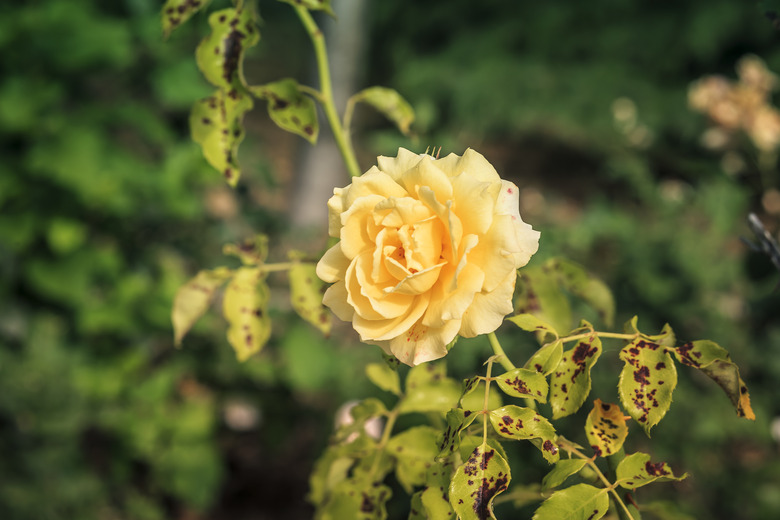How To Get Rid Of Brown Spots On Rose Leaves
Brown spots on rose leaves are among the most common problems encountered by gardeners. Rose bushes are among the more difficult flowering plants to grow, primarily because they are vulnerable to a wide range of plant diseases. Those who wish to garden organically don't have the wide arsenal of chemical sprays to turn to that solve all their rose problems in one spray but may have deleterious effects on the environment. Fortunately, organic methods of getting rid of brown spots on rose leaves are available.
Things Needed
-
Organic fungicide, or baking soda
-
Insecticidal soap (optional)
How to Get Rid of Brown Spots on Rose Leaves
1. Use Careful Watering Practices
Prevent brown spots before they become a problem by practicing careful watering. Brown spots on roses are nearly always the result of a fungal infection; hence, good moisture control is essential to keeping these infections at bay. Avoid watering the leaves of a rose bush, only the root area. Avoid allowing plants to become crowded by observing proper spacing when planting them and keeping them pruned, and don't plant roses in a high-humidity area of your garden, such as an area that receives less sun or where mold or mildew problems have occurred before.
2. Prune Rose Bushes
Prune rose bushes well to promote healthy growth and to allow air circulation around your rose bushes as well as within the interior. Clean and sanitize your pruning shears and any other garden implements that touch roses, to prevent spreading fungal pathogens from one plant to another.
3. Check for Too Much Sun
Inspect plants to verify that the problem is, in fact, fungal. True brown spots are; however, brown curled edges of leaves may be a sign of scorching. Observe whether the spots are evenly distributed on the leaf or whether the browning is at the edges. If it's primarily at the edges, and the leaves are curled as well as discolored, excessive sun exposure may be the culprit. Curling leaves may also be a result of a virus, for which there is no cure. Another reason for brown curled leaf edges is excessive fertilization.
4. Move the Rose
Move the plant to a shadier area after the last flowering if the cause is too much sunlight.
5. Check for Pest Infestation
Look for signs that the brown spots are caused by pests instead of a fungal disease. If the spots are yellowish, rather than brown, insects may be the cause. Look for pests on the leaves to confirm.
6. Apply Insecticidal Soap
Apply insecticidal soap if the symptoms indicate a pest problem instead of a fungal issue. Be aware, however, that insecticidal soap can damage some roses. Check the product label to make sure roses aren't on the list of plants to avoid; if they're not, first test-spray a small area on the plant to determine if your specific cultivar may be sensitive to the soap. Premixed insecticidal soap is easy to spray directly on the roses without diluting. Ensure that you spray all affected areas. Since the insecticidal soap only works on the pests that are actually on the plant when you apply it, you might need to reapply the insecticidal soap each week or every other week to contain the insect problem. Always consult the label for reapplication rates and intervals.
7. Apply Organic Fungicide
Spray rose leaves with organic fungicide if a fungal problem has been established. Follow the package instructions exactly to treat the rose bushes, making sure the product is safe for use on roses.
8. Reapply Fungal Treatments
Reapply fungal sprays once a week, or according to label-specific directions if they vary from this recommendation, and after any rainfall. If the infestation is small, remove diseased leaves and discard them in the garbage. Don't discard them outdoors, since this can lead to the fungus spreading.
